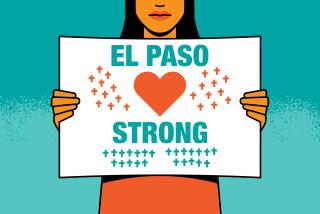Understanding the Riots Part 4 : Seeing Ourselves : MEXICO CITY : It’s easier to see problems in someone else’s country.
- Share via
They all ask. Neighbors, vendors, taxi drivers. They saw the Rodney G. King beating on television here too and can’t understand. How could a jury possibly find the four white officers not guilty?
The incredulous tone in their voices seems to be saying, “You’re a gringa . You explain it.”
Why, they ask, did blacks and Latinos turn on their own neighborhoods?
I find myself at a loss for words, numbly groping for something to say about hate, racism and rage in the United States. Like so many Americans abroad, I am thrust into the position of trying to defend what I find indefensible in my own country.
This is a new experience for me. As a reporter, I am usually the one asking questions.
So many times when I have interviewed Mexicans about injustices in their country, they lash out angrily at their government and compatriots, only to stop abruptly, horrified that they have committed a terrible indiscretion. Mexicans believe they should not air their dirty laundry in public, much less in front of the gringos .
I never really understood their embarrassment. Until now, perhaps. Now it’s my turn.
“You know,” said a cab driver who had watched the rioting on television. “In Los Angeles there are neighborhoods where only blacks live. They live apart. I thought that ended years ago.”
His voice rose slightly, asking me to confirm what he was already telling me--that there is apartheid in L.A.
It reminded me of a trip I made to Los Angeles last October with the Salvadoran woman who cares for my 1-year-old daughter. It was her first time in the United States. She visited low-income neighborhoods on city buses--a cousin in Pico Rivera, Salvadoran friends in Altadena and North Hollywood. In the end, she came to Santa Monica and took my daughter to the park, where she encountered a host of Central American nannies.
On the way back to Mexico, I asked her about her impression of the United States.
“It was good,” she said, pausing to reflect. “But I thought I was going to see some gringos there.”
The fact that hundreds of Mexicans and Central Americans arrested during the uprising were turned over to the Immigration and Naturalization Service and deported was not lost here.
“In a sense, this (uprising) is an internal affair for Mexico,” columnist Miguel Angel Granados Chapa wrote in the daily newspaper El Financiero. “The violent rejection . . . of undocumented Mexicans in the United States, and of those who yearn to enter those lands to work, will grow and will be socially justified by the recent events in Los Angeles.”
He added that the real issues of racial discrimination and police immunity were lost in the tumult.
El Financiero columnist Sergio Sarmiento agreed: “The failure of U.S. society to guarantee true justice to all its population, and the dramatic differences of income between ethnic groups has brought into perspective the undeniable defects of the U.S. system.”
Or, as a political cartoonist put it simply in a drawing of President Bush carrying a broom outside a ruined storefront: “New World Economic Order.”
Economic disorder. Apartheid. It’s always easier to see in someone else’s country.
More to Read
Sign up for Essential California
The most important California stories and recommendations in your inbox every morning.
You may occasionally receive promotional content from the Los Angeles Times.













